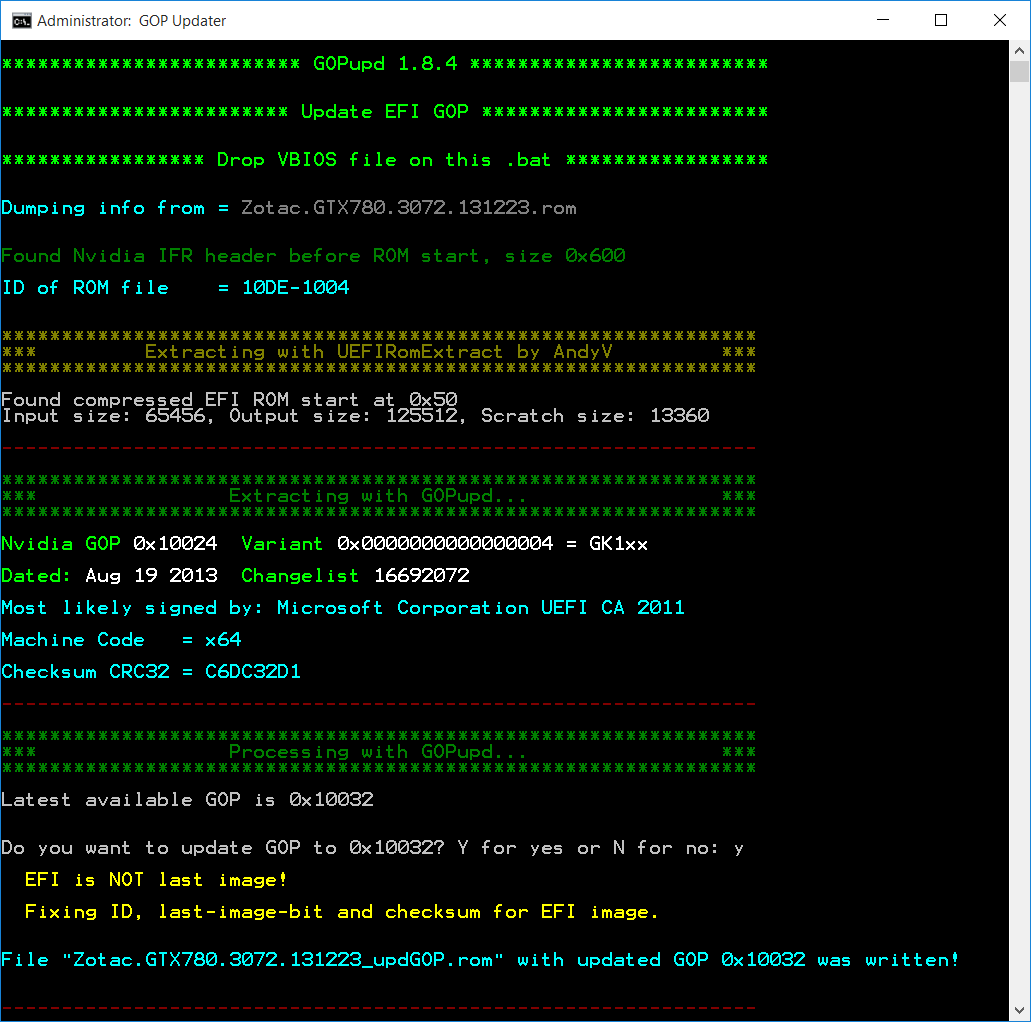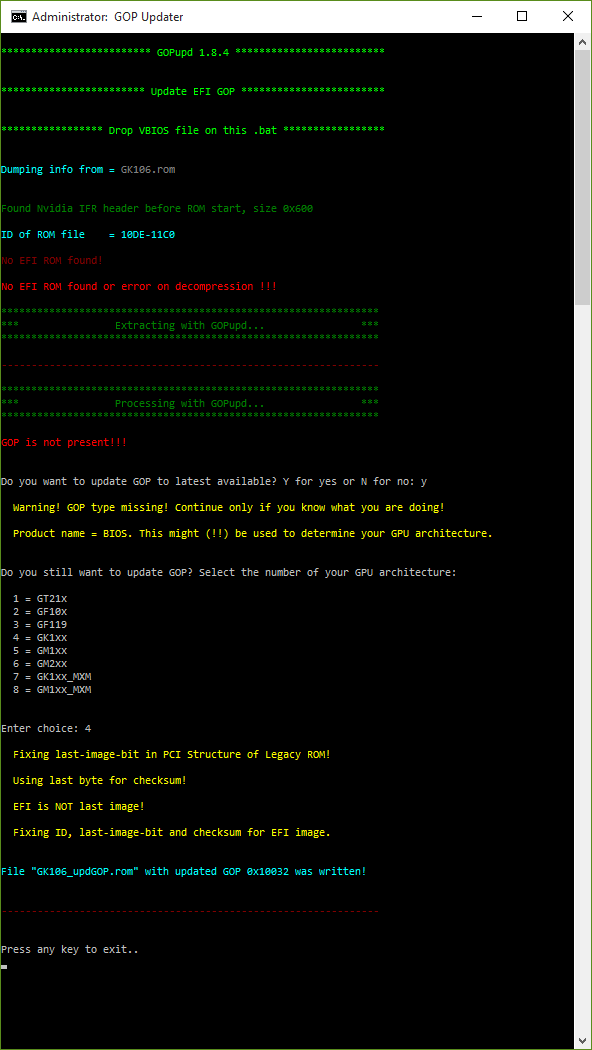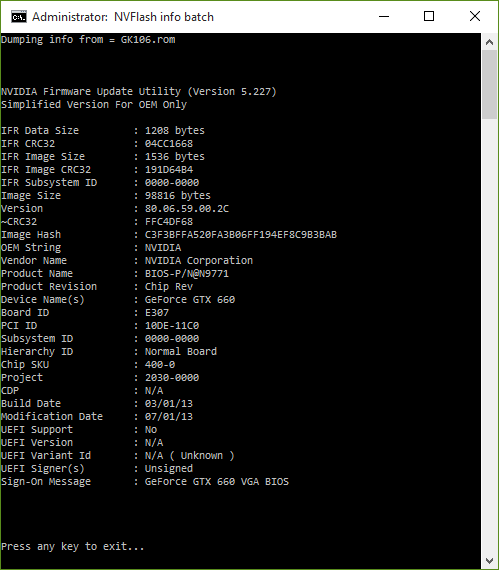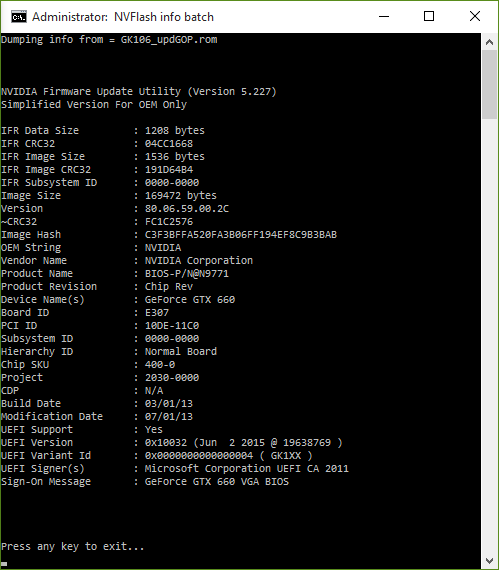The .BAT file is working fine on my system. Are you sure you have used the right way ?
Anyway, here is your updated .ROM file
ZotacUPD.zip (135 KB)
The .BAT file is working fine on my system. Are you sure you have used the right way ?
Anyway, here is your updated .ROM file
ZotacUPD.zip (135 KB)
Wow Superrr 
 Thanks…
Thanks…
@lordkag
I flashed the bios modified (120 Kb) without problem. Now the Ultra Fast Boot works. Thank you very much
@tecnics
You probably did something wrong, as I have no problem in running it on Win10. It is not my daily OS, but I tried with numerous samples and test cases since RTM was released.

My little guess is you double clicked on GOPupd.bat instead of doing what it is written on first post, to drop the VBIOS on GOPupd.bat. I cannot account for all the extensions that OEM use, dropping the file on GOPupd.bat is the only way I know what file to process, not to mention that this way I can bulk test many files at once.
@d4v1d3
Thank you for the feedback. If I’m not mistaken, it is the first AMD report. More than that, it is on a card that is labelled as incompatible, if you were to ask AMD and other manufacturers.
I was semi successful in enabling GOP on my 2 GTX 680s(GK104). Patched ROMs with GK1xx GOP(option 4) and flashed. Managed to boot with CSM disabled and didn’t get the usual message that my GPUs were not UEFI capable.
But after a couple of reboots my 1440p monitor connected via displayport started to boot in Windows 10 at 1080p, display properties showed that was the max resolution available, there was no 1440p option. At first it was stacked at 1080p avery other boot but after some tries it was stuck continuously at 1080p max. Enabled CSM and problem persisted, reverted back to the unpatched roms still the same. After cutting power to the motherboard, CMOS reset and reapplying my BIOS settings, the monitor was recognized as 1440p.
Can’t exclude that it could be a bug of my MB’s BIOS.
Attached is a zipped file containing both the unpatched and the patched rom.
Also attached is a GTX650 ROM that is factory UEFI enabled.
680_4GB_Roms.zip (180 KB)
650_UEFI_Enabled.zip (120 KB)
I see no issue in the updated file. As a rule of thumb, it is recommended to shutdown the system after the flash is successful. For Win8.x/Win10 it is also recommended to restart the system, as this is the way to fully reload the OS like shutdown was for Win7. For UEFI systems (basically anyone who comes here), you could also start the system once with Fast Boot disabled. I know this is the opposite of what you wanted, but you need to let the system to acknowledge the new hardware or firmware before switching to Fast Boot. Lastly, the CMOS reset is always recommended when you see the BIOS going crazy.
If the issue will return, write here and I will provide some older versions of GK1xx GOP, just to rule out any problems in the last version.
@lordkag
Many shutdowns (cold shutdowns too) and reboots were done, the only thing I didn’t test is a CMOS reset with the GOP enabled and checking if the problem persists also with a DVI connection. I also tried unpluging and repluging the monitor and cutting its power in hopes it would be correctly regognized. After some reboots sometimes the problem would fix itself and the max resolution would be recognized but eventually it got stuck at 1080p.
Will try again this weekend when I have some free time and see if I can get it to work, thankfully reflashing is quite painless. I will also try if the problem appears in Windows 8.1 too.
Any suggestions for something to check inside windows, any settings?
Are you saying the problem is still there after a CMOS reset? How about if you boot with CSM disabled and Fast Boot also disabled? I’m not sure if Windows is at blame, but I remember reading at ROG forums and at Nvidia driver releases about monitor issues. I suspect you don’t have a different monitor laying around, so investigating the driver route is the only available option.
The problem fixed itself after the CMOS reset but I had also previously flashed back the original ROM, simply flashing the original ROM didn’t fix the problem and didn’t test a CMOS reset with the modded ROM. Also disabled CSM and Fast Boot and this also didn’t fix the problem with both modded and unmodded ROM. I have another monitor and a HDTV but probably the problem won’t appear there as they are both 1080p and the problem appears to be with higher resolutions.
Another idea I had just now is next time the problem appears to see what MonitorInfoView reads about the capabilities of the monitor.
Reflashed the GOP ROM and tested my PC again. Did a lot of restarts(cold ones too), changed BIOS settings and everything worked OK for most of the day.
After shutdown for 3 hours and starting up, the problem appeared again. My monitor was recognized as 1080P(Ultra HD, HD,SD section) and 1050P(PC section), AFAIK MonitorInfoView correctly recognized my monitor and all its capabilities (1440P).
- Changed to Windows 8.1 which had also an older NVIDIA driver and the problem persisted.
- The problem doesn’t affect the DVI port only DisplayPort.
- Changing any display related settings(boot image, show ROM) or disabling fast boot/enabling CSM in BIOS doesn’t fix the problem.
- Forcing the 1440P resolution by creating a custom resolution, sends a downscaled 1440P to 1080P resolution to the monitor.
- If you go to BIOS via the UEFI settings option of Windows 10 and then exit to Windows, then the problem will go away for that Windows session, it will come back next boot/restart.
- The problem persists if you flash the original ROM until you fix it via a BIOS reset or going to BIOS via the UEFI settings option of Windows 10.
Correct if I am wrong, doesn’t the GPU ROM contain info regarding the ports of the graphics card and flashing a ROM from another cards with different ports could possibly disable a port.
Could the EFI GOP that I am flashing having different info for the ports causing my DisplayPort malfunctioning?
Or could it be a problem with my MB’s BIOS?
I am back now to the original ROM, everything works OK and probably will stay here as I don’t want to test my luck with a bricked card from a failed flash.
Thanks for your work.
The fact that it manifests only after an amount of time needs to be considered as a sign that the modded file is OK from assembly point. It would fail from the beginning if there would be something wrong in my code. The fact that it happens after a long shutdown could point to a mainboard issue, i.e. corruption of CMOS data or port failing. You ruled out Windows or drivers with the first test. The GOP works, I don’t see the GOP to be causing this much trouble, to work perfectly fine and then to mysteriously collapse in the same conditions. The tests with DVI and Win10 -> UEFI settings -> Win10 also prove that GOP and monitor are OK, the issue is elsewhere. What is left?
- flashing the original ROM should definitely fix the issue immediately. You restored the card to initial conditions, the hardware is the same (PC, card, monitor), the only part that could be left in an altered state is the CMOS data and UEFI variables. Proof: a BIOS reset also fixes the issue.
- the EFI code loads the settings from the legacy ROM, that’s why it is generic and one-time signed. Otherwise this thread would not exist. If every card would need a specific GOP, how would I create it and sign it? AMD did this laborious work at some point in the past, but they also switched to a universal GOP.
- when switching CSM to enable and not forcing EFI compatible, the legacy ROM is loaded, even when the card has a GOP. The only difference between your original ROM and legacy ROM from updated file is the bit that signals a linked image and the checksum. That linked image contains the GOP and it is not loaded in the conditions mentioned at the beginning. This means that original image and updated image should be identical code-wise when enabling CSM.
- I don’t see this issue coming from VGA card, display, DisplayPort. I’m inclining to mainboard, specifically the BIOS/UEFI firmware. You should check the mainboard manufacturer for an updated BIOS and also open a support ticket.
Hi there,
I’ve read your 1st post and here’s the result of the tool:

and the screenshot of double checking (kind of useless, but i’ll provide it anyway)
[[File:double check (stock rom).png]] [[File:double check (updated rom).png]]
despite of your notice “If a user is not accustomed with flashing his GPU, he/she should not proceed with this GOP update,” I really want to flash my GPU to enable the ultra fast boot option.
can you help me through the flashing process?
which nvflash version should I use? (I read that certain GPU model requires specific version)
considering that my motherboard doesn’t have integrated GPU, how can I rollback to the stock rom if something went wrong?
thanks in advance.


roms.zip (183 KB)
Having an old card, you should better use NVFlash 5.199. But being on Win10, you need 5.2xx version for better compatibility between OS and nvflash driver. What I suggest is to follow this link and test from latest 5.227 and go down until 5.199, until you find one that flashes your card. It is better to use the last version, but if that doesn’t work, it will just print an error message.
As for the flashing, you should read this topic, but skip the part of disabling the card, it is not needed for yours. For blind flashing a bricked card you can read this topic, skip to step 4. I know it is old, but the idea is the same. You need to make a bootable USB, add from here, put your original VBIOS in the same folder and edit autoexec.bat with the flash command, so it will auto-flash without you doing a thing. This USB needs to be prepared before flashing updated VBIOS and you also need to put the USB higher in the Boot priority.
thank you very much. I’ve flashed my GPU without major problems.
I want to share my experience though:
- using nvflash 5.227
- when I start flashing (no confirmation yet), my second monitor disconnected and the cmd window gone (started to panic a bit)
- I tried to run another version of nvflash, but got an error: unable to setup nvflash driver 00000020
- try to research a bit, but no luck
- suddenly I was thinking to disable the card on device manager
- I realized that the card is disabled (maybe nvflash automatically disable it?)
- I then re-enable the card, my second monitor connected again, also the first command-line window appeared! (it’s still waiting for confirmation)
- I pressed ‘y’, and the flashing went smoothly.
- done! restart the pc, enable fast boot & secure boot.
by the way, the startup time still takes about ~18 secs (from power up until logon screen), which I believe is longer than usual <10 secs. is there anything wrong? just curious.
I disabled “MSI fast boot” and enabled “fast boot” option on my bios
@ candrabeqx:
Welcome at Win-RAID Forum and thanks for your report, which may help other users with a similar problem.
It is fine, that you succeeded with lordkag’s help.
Regards
Dieter (alias Fernando)
Knight reporting back:
@candrabeqx
The new NVFlash is designed to automatically disable the card in Device Manager, as a requirement for flashing Maxwell cards. Apparently it does the same thing for older cards, probably as a way to ensure the flashing process goes smoothly. What happened in your case is that the command window was hidden after this step. This was either a glitch in the OS, or the window was masked/minimized and you didn’t see it in the taskbar (it can happen to all). I forgot to mention that the new NVFlash will throw an error only on those card without a signature in the first place. Your card has one, thus NVFlash 5.227 was the obvious choice. For your other issue with not-so-fast boot, you will have to make a new thread or investigate on your own. If Fast Boot is enabled and it works, then this thread has done its business. The problem is often in the mainboard’s UEFI firmware, I don’t want the GOP updating reports to get cluttered with those unrelated issues.
@plutomaniac
Sir Plutomaniac, for the services you have offered to this thread, you have earned yourself a new title. From this day on, we shall call thee Sir Plutomaniac the Finder. To receive your title, kneel before… Actually, skip this part, it might get interpreted badly by the court.
Released version 1.8.5:
- updated GM1xx to 0x10032, thanks to Plutomaniac
- updated GM1xx_MXM to 0x10031, thanks to Plutomaniac (he doesn’t know it yet)
Nvflash v5.229 + some other tools (no new GOP)
970M_SLI_Reflash_ZPE.rar (1.67 MB)
Useful update, especially the nvrominfo file, that works with -v command. Unfortunately, they are all x64, can’t add them to GOPupd. I’ve just tested a few things: nvrominfo is the same size as nvflash and nvflash can be used without .sys files, so I will use the latest x86 from nvflash/nvrominfo; atiflash only needs ULPSCtrl.dll to show the info, so I will use the latest x86 from GopInfoX/AtiFlash+ULPSCtrl.dll